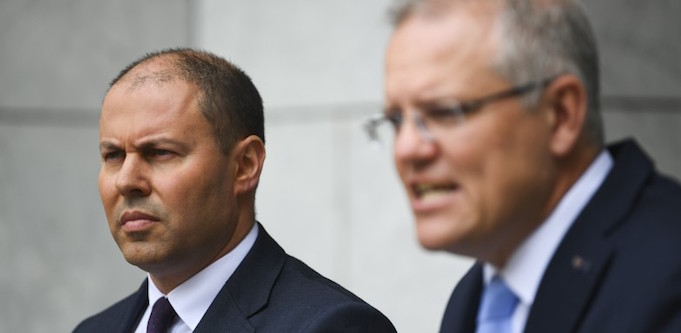
The government wants to cut the R&D tax incentive. Source: AAP/Lukas Coch.
More Australian businesses will keep receiving JobKeeper wage subsidies from September, with the federal government to ease the eligibility criteria for both businesses and employees in response to the stricter lockdowns in Victoria.
Businesses will now only need to show their GST turnover has fallen in one quarter, instead of two, to qualify for the extension of the scheme, which is due to come into effect at the end of September.
When the government first announced the extension of the JobKeeper program last month, it said businesses would need to show a decline in turnover for both the June and September quarters in order to be eligible for the extension of the program.
However, under changes announced today, the new JobKeeper eligibility criteria mean businesses will now only need to show that GST turnover has fallen in the September quarter, compared to the corresponding period in 2019.
These changes will also apply to the second extension of JobKeeper, which will begin at the start of January 2021.
Under the previously announced turnover tests, businesses would have needed to show a decline in GST turnover for the June, September and December quarters of this year.
Now, businesses will only need to have experienced a turnover decline for the December quarter to qualify for the January extension of JobKeeper.
There will also be changes for employee eligibility, with employees eligible for the wage subsidies extension if they have been working for their employer since at least July 1, 2020, instead of the original deadline of March 1, 2020.
To determine which tier of JobKepeer payments employees are eligible for, employers will need to use the two fortnightly pay periods to either March 1, 2020, or July 1, 2020. If an employee has been eligible for JobKeeper since March 1, the fortnightly period with the highest number of hours worked will be used.
The planned reductions in the JobKeeper payments will still go ahead. This means the JobKeeper rate will still drop from $1,500 to $1,200 for full-time workers, and to $750 for part-time workers, from October.
The payments will then change to $1,000 per fortnight for full-time workers and $650 for part-time workers from January.
Today’s changes are designed to provide support for businesses that may have seen some recovery in their revenues in April, May and June before the last restrictions came into play, and therefore, may have missed out on the next phase of the JobKeeper scheme.
Speaking to the ABC, Treasurer Josh Frydenberg said the changes will mean the government will spend an additional $15.6 billion on the JobKeeper program, and $13 billion of that is expected to go towards supporting Victorian businesses and employees.
“We’re deeply concerned about the economic blow to the national economy and, particularly, the Victorian economy from the coronavirus spread,” he said.
Speaking on radio station 2GB this morning, Prime Minister Scott Morrison said the changes apply to all Australian businesses, whenever they are located, but the JobKeeper scheme is “there when the virus hits and it’s hit hard in Victoria in particular”.
“There’ll be some additional people who get access to it, we expect in other states and territories, but it’s principally Victoria,” he said.
James Pearson, chief executive of the Australian Chamber of Commerce and Industry (ACCI), said in a statement the new turnover tests and eligibility criteria will “save jobs that were sure to be lost as a result of revenue slumping in the face of Victoria’s lockdown and tighter border restrictions in the virus’ second wave”.
Pearson said the government had listened to the chamber’s concerns about the previous eligibility guidelines for the extension of the wage subsidy scheme.
“Within hours of July’s JobKeeper 2.0 announcement, ACCI and our members identified two issues which needed to be addressed,” he said.
“The first was the need for businesses to show they would meet the downturn threshold in each quarter to be eligible. Many had started to trade out of the June quarter as restrictions eased but were forced back into shut down within weeks.
“We saw a brief uptick in sales in some industries due to the instant asset write-off scheme, superannuation funds being released and hospitality reopening — but this recovery was short-lived for many businesses.”
“ACCI also made the case to government for shifting the date of eligible employees from March to July,” Pearson added.
“The trading restart in May and June saw new employees join the books, if only for a matter of weeks, before being stood down again.”
Further information about the changes to JobKeeper eligibility tests is available here.
NOW READ: Morrison grants paid pandemic leave to Victorians who need to self-isolate


COMMENTS
SmartCompany is committed to hosting lively discussions. Help us keep the conversation useful, interesting and welcoming. We aim to publish comments quickly in the interest of promoting robust conversation, but we’re a small team and we deploy filters to protect against legal risk. Occasionally your comment may be held up while it is being reviewed, but we’re working as fast as we can to keep the conversation rolling.
The SmartCompany comment section is members-only content. Please subscribe to leave a comment.
The SmartCompany comment section is members-only content. Please login to leave a comment.